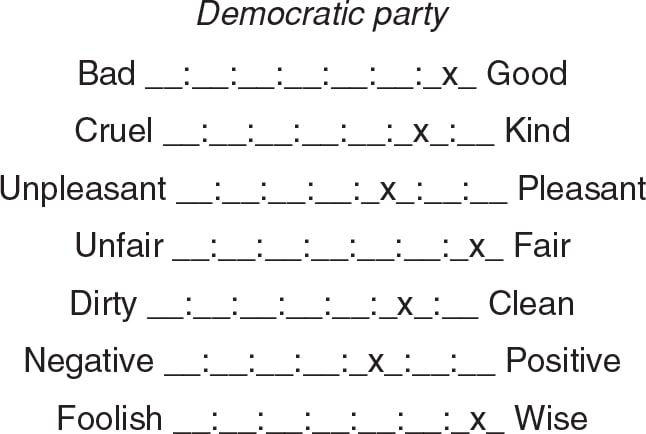On This Page:
The Semantic Differential Scale is a tool commonly used in linguistics and social psychology to measure social attitudes. Introduced by Osgood, Suci, and Tannenbaum in 1957, it usually employs a seven-point bipolar rating system with opposing adjectives, though some studies use five or six-point scales.
The semantic differential technique of Osgood et al. (1957) asks a person to rate an issue or topic on a standard set of bipolar adjectives (i.e., with opposite meanings), each representing a seven-point scale.

How it Works
-
Selection of a Concept: Choose the concept, idea, brand, or item you want to measure. This could be anything from a product, service, brand, to even an abstract idea.
-
Bipolar Adjective Pairs: Develop a list of bipolar (opposite) adjectives. These pairs will act as the endpoints of your scale, reflecting the dimensions you want to measure (e.g., “Good-Bad”, “Fast-Slow”). A pilot study is typically conducted to determine the most suitable measures for the main study.
-
Constructing the Scale: Typically, a 5-point, 7-point, or sometimes even a 9-point scale is used. Place your bipolar adjectives at either end of this scale:
Happy -----------|-----------|-----------|-----------|-----------|-----------|----------- Sad -
Survey Deployment: Distribute the scale to your intended audience. Ask participants to place a mark on the continuum between the paired adjectives, indicating their perception or feeling about the concept.
-
Analysis: After collecting responses, the data can be analyzed by computing average scores or distributions for each bipolar adjective pair. This provides insights into how respondents perceive the concept across different dimensions.
-
Interpretation: The positions marked by respondents on the scale indicate their attitudes or feelings. For example, if most respondents mark closer to “Happy” for a product, it indicates a positive sentiment towards that product.
Dimensions
The semantic differential technique reveals three basic dimensions of attitudes: evaluation, potency (i.e., strength), and activity.
• Evaluation is concerned with whether a person thinks positively or negatively about the attitude topic (e.g. dirty – clean, and ugly – beautiful).
• Potency is concerned with how powerful the topic is for the person (e.g. cruel – kind, and strong – weak).
• Activity is concerned with whether the topic is seen as active or passive (e.g. active – passive).
By assessing attitudes across these three dimensions, the Semantic Differential Scale offers a nuanced and multi-faceted view of a respondent’s perception.
For example, a brand might be perceived as strong (Potency) but not necessarily good (Value), and understanding these nuances can be invaluable for marketers, researchers, and other professionals.
Using this information, we can see if a person’s feeling (evaluation) towards an object is consistent with their behavior. For example, a place might like the taste of chocolate (evaluative) but not eat it often (activity).
Social psychologists have mostly used the evaluation dimension to measure a person’s attitude because this dimension reflects the affective aspect of an attitude.
Example
Concept Being Evaluated: XYZ Coffee Brand
Please indicate where your perception of XYZ Coffee Brand falls on the following scales:
-
Taste
Bland ———–|———–|———–|———–|———–|———–|———– Flavorful -
Aroma
Weak ———–|———–|———–|———–|———–|———–|———– Strong -
Price
Expensive ———–|———–|———–|———–|———–|———–|———– Affordable -
Packaging
Unattractive ———–|———–|———–|———–|———–|———–|———– Attractive -
Strength
Mild ———–|———–|———–|———–|———–|———–|———– Robust -
Aftertaste
Unpleasant ———–|———–|———–|———–|———–|———–|———– Pleasant
Respondents would then mark on the continuum between the bipolar adjectives based on their perceptions of the XYZ Coffee Brand. The results will give an insight into how the new coffee brand is perceived across different attributes.
Evaluation
The strength of this scale lies in its ability to capture both the direction (e.g., is the attitude positive or negative?) and the intensity (e.g., how positive or negative?) of a respondent’s feelings or perceptions about the given concept. Analyzing the results often involves calculating mean scores for each item to determine general attitudes or perceptions.
An attitude scale is designed to provide a valid or accurate measure of an individual’s social attitude. However, anyone who has ever “faked” an attitude scale knows there are shortcomings in these self-report attitudes scales.
Various problems affect the validity of attitude scales. However, the most common problem is that of social desirability.
Socially desirability refers to the tendency for people to give “socially desirable” to the questionnaire items. People are often motivated to give replies that make them appear “well adjusted,” unprejudiced, open-minded, and democratic. Self-report scales that measure attitudes towards race, religion, sex, etc., are heavily affected by social desirability bias.
Respondents who harbor a negative attitude towards a particular group may not wish to admit to the experimenter (or themselves) that they have these feelings. Consequently, responses on attitude scales are not always 100% valid.
References
- Al-Hindawe, J. (1996). Considerations when constructing a semantic differential scale.
- Buck, J. N. (1948). The HTP test. Journal of Clinical Psychology.
- Heise, D. R. (1969). Some methodological issues in semantic differential research. Psychological Bulletin, 72(6), 406.
- Heise, D. R. (1970). The semantic differential and attitude research. Attitude measurement, 4, 235-253.
- Garland, R. (1990). A comparison of three forms of the semantic differential. Marketing Bulletin, 1(1), 19-24.
- Osgood, C.E, Suci, G., & Tannenbaum, P. (1957). The Measurement of Meaning. University of Illinois Press, 1.

